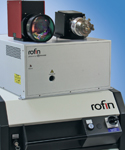5 October 2012
Lasers for Ablation & Structuring In Medical Device Applications
 With the advent of new manufacturing technologies, medical device manufacturers are able to produce more innovative and less intrusive devices with greater benefit to patients and lower costs.
With the advent of new manufacturing technologies, medical device manufacturers are able to produce more innovative and less intrusive devices with greater benefit to patients and lower costs.
The latest generation of lasers are capable of ultra-short pulses, which allow medical devices made from virtually any material to be successfully ablated. This can be used to create machine readable codes for traceability without any heat affected zone or collateral damage to the surrounding material. It is also possible to selectively remove layers of material without damage or de-lamination of underlying material.
Lasers can, very precisely and repeatably, ablate material from metals, ceramics or polymers. Using ultra-short pulses, either in the picosecond or femtosecond regime, it is possible to created very high peak power pulses which can ablate material without creating thermal damage. This process can either remove an entire surface layer or create microstructures smaller than 15 microns in width.
For example, laser ablation can be used to remove polymer layers from metallic filaments in the production of catheters, or implantable electronic devices. The same techniques can be used to create very accurate holes in polymers with no damage to the surface or around the entry or exit of the hole. The selective removal of the material depends on the wavelength and the pulse duration of the laser.
The StarFemto series of laser sources from Rofin produces laser pulses shorter than 1 picosecond (the time taken for light to travel 0.33 mm) accomplish precise and selective ablation of work-piece surfaces using the ablation process – the ideal basis for micro structuring, drilling, cutting or scribing.
Process and Application Flexibility
Dynamic beam technology using galvo-deflection optics is the optimum choice if speed is required, as the laser beam can be moved much more quickly than a heavy work-piece. Of course, all of the lasers can be equipped with fixed optics if required. With the choice of various power levels, wavelengths, pulse widths and the flexibility of beam delivery – Rofin solid-state lasers cover a huge range of applications within the medical device industry.
- Contact Information
- Name: Dave MacLellan
- Email: sales@rofin-baasel.co.uk
- Website: www.rofin.co.uk

